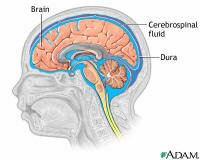Topic Search: PubMed

In the News:
-
July 2017: Central nervous system relapse of diffuse large B-cell lymphoma in the rituximab era: Results of the UK NCRI R-CHOP-14 versus 21 trial | Annals of Oncology | Oxford Academic http://bit.ly/2vFkhPE
snip: Conclusion: Despite very limited use of IV MTX as prophylaxis, the incidence of CNS relapse following R-CHOP was very low (1.9%) confirming the reduced incidence in the rituximab era. The CNS-IPI identified patients at highest risk for CNS recurrence.
Preventive Therapy (Prophylaxis) for CNS Involvement
Adapted from James O. Armitage, Mayo Clin Proc. 2012
My Treatment Approach to Patients With Diffuse Large B-Cell Lymphoma http://1.usa.gov/114VX2w
"It is clear that most patients with diffuse large B-cell lymphoma are at a low risk of CNS metastasis."
Patients thought to be at higher risk for developing CNS involvement may receive prophylactic therapy to attempt to reduce its frequency.
.gif) |
Relapse in the CNS (Central Nervous System) following treatment for DLBCL is one of most serious complications
|
.gif) |
CNS relapse can involve the cerebrospinal fluid,
meninges (membranes that envelope the central nervous system), or the brain.
|
.gif) |
This is a serious complication, but some patients who develop CNS metastasis after apparently successful treatment for systemic DLBCL can be rescued with autologous stem cell transplant.
|
.gif) |
The most common treatment are intrathecal methotrexate with or without cytarabine with or without additional intravenous high-dose methotrexate.
|
.gif) |
Incidence / risk of this complication:
Two large series of patients treated using this approach found an incidence of CNS relapse between 1% and 2%.
However, in 2 large series of patients in which CNS prophylaxis was not routinely given, the incidence of CNS relapse was 2.2% and 2.8% - [not much higher].
In a recent report the incidence of CNS relapse in patients who received rituximab with CHOP was significantly lower than that in patients who received CHOP alone (6.4% vs 9.7%), and the results were even more striking for patients who achieved a complete remission (5.8% vs 2.2%), suggesting that use of Rituxan might reduce the incidence.
Similar results were reported at the University of Nebraska Medical Center,
with a CNS relapse rate of 3.6% with CHOP and 2.2% with CHOP-R (P=.05).
The value of prophylaxis treatment might be marginal.
|
.gif) |
Factors associated with CNS relapse include specific sites of involvement
nasopharyngeal,
epidural,
testicular,
breast,
adrenal gland,
bone, and bone marrow
Other factors associated with increased risk of CNS relapse:
high serum lactate dehydrogenase,
low serum albumin,
age younger than 60 years, and
more extensive disease.
|
.gif) |
CNS prophylaxis is often given with each cycle of CHOP-R to patients who present with
epidural involvement,
nasopharyngeal involvement,
testicular involvement, and
involvement of the bone marrow by large cell lymphoma
OR when DLBCL presents in unusual extranodal sites such as
adrenal gland, kidney, and bone.
|
.gif) |
It appears that some patients destined to develop meningeal metastasis have cells present in the spinal fluid at diagnosis that can be detected by flow cytometry. Such tests might be one way to identify patients who should have aggressive “prophylactic” therapy.
|
|